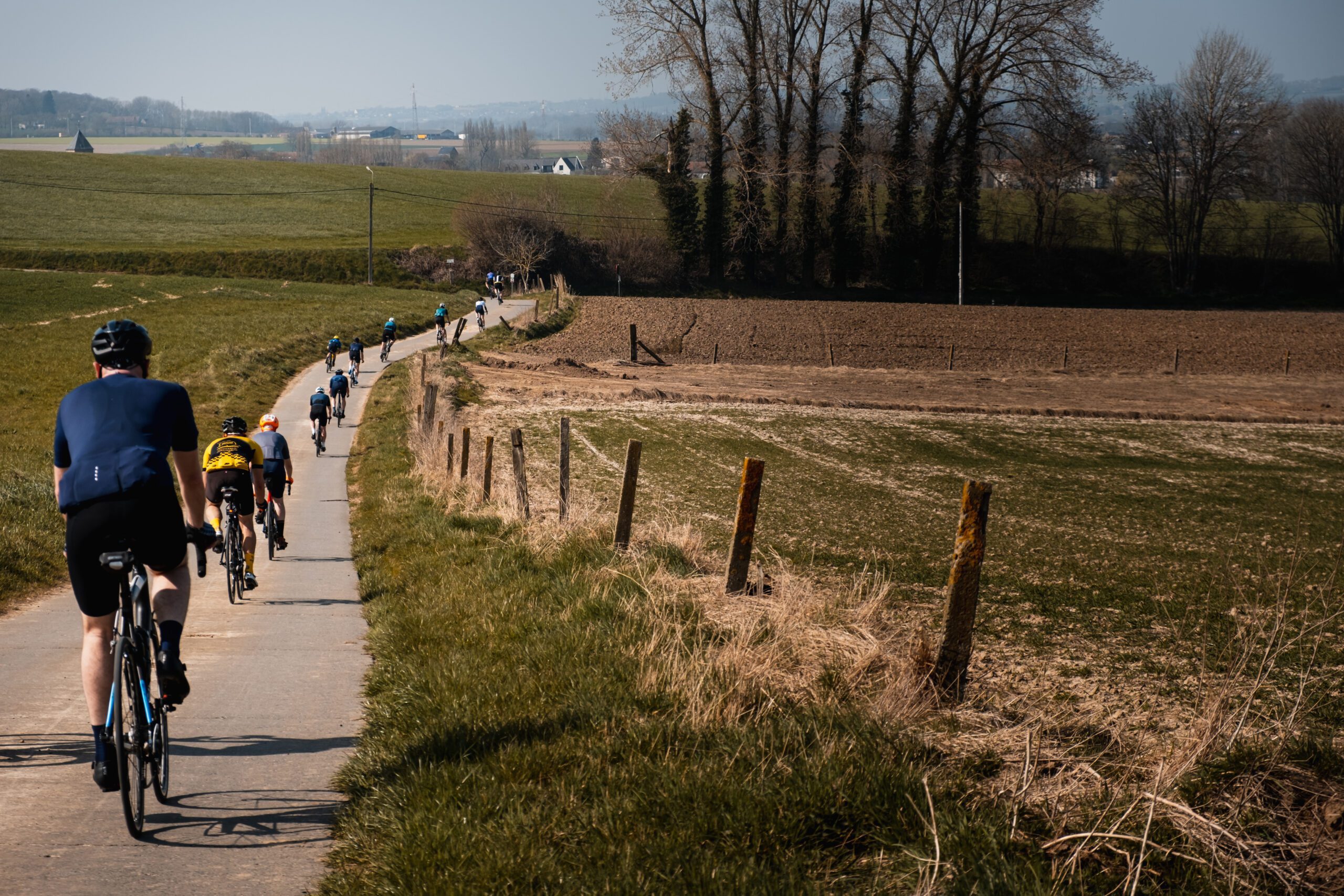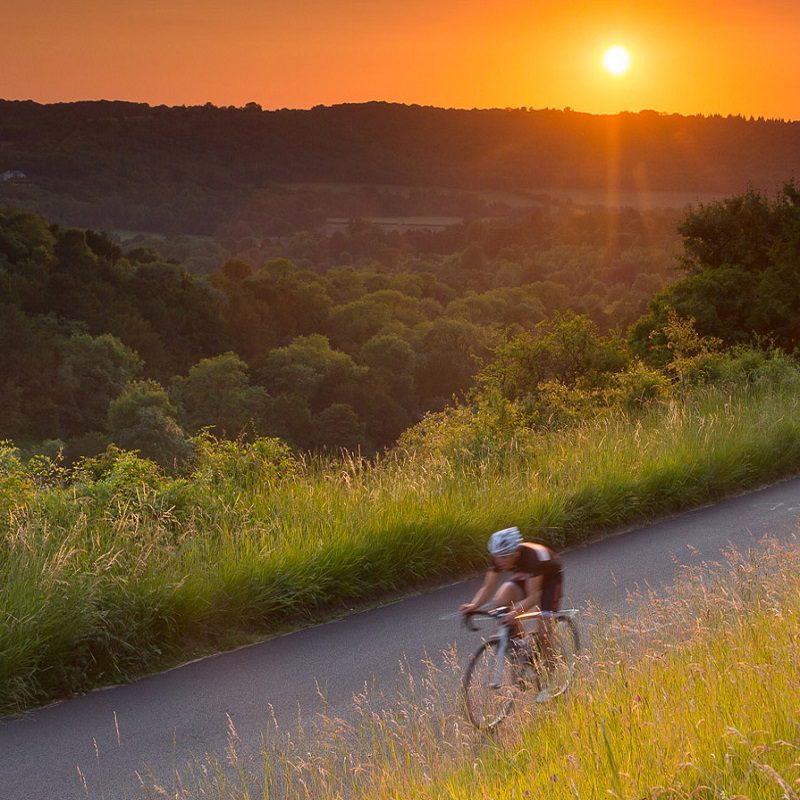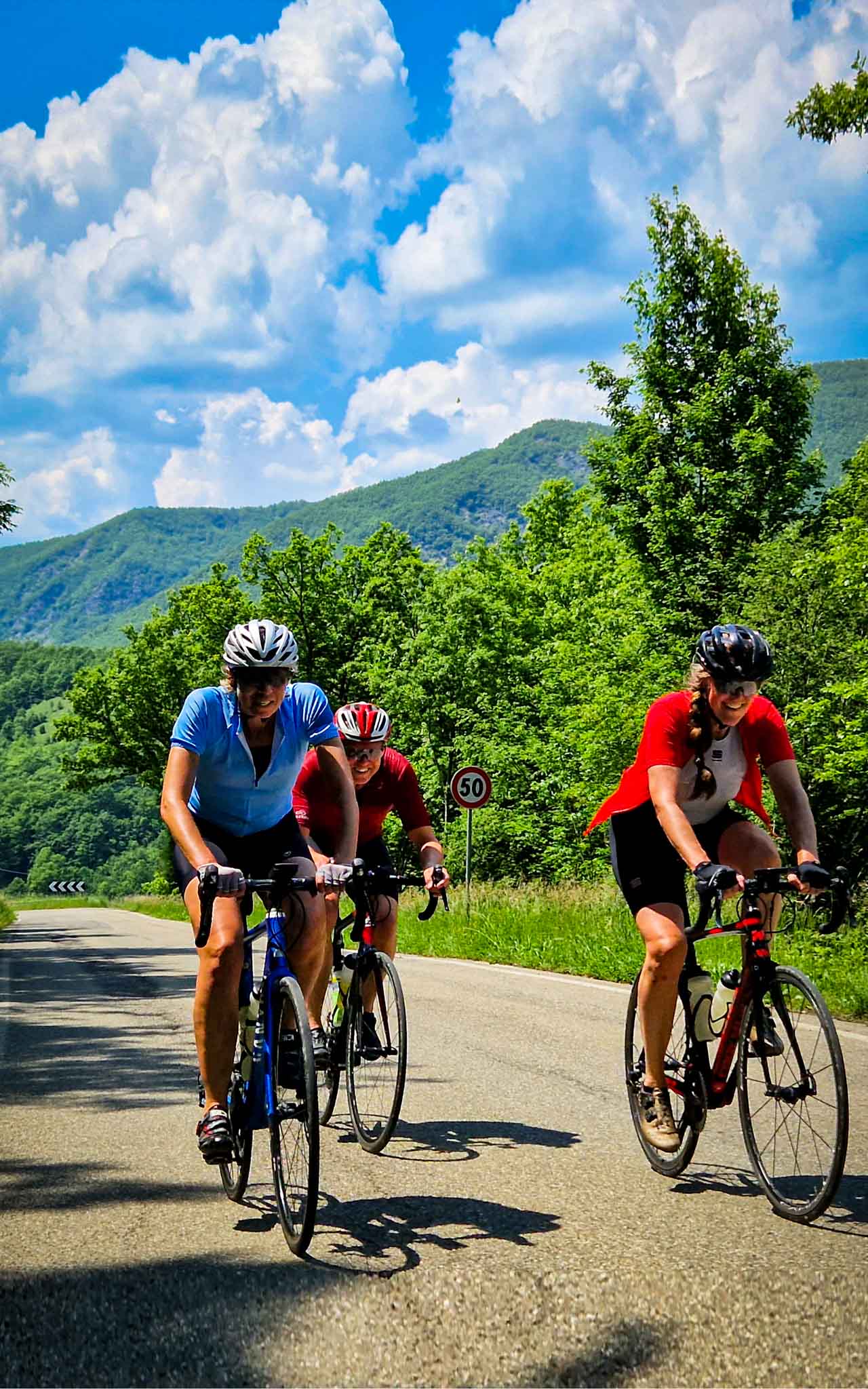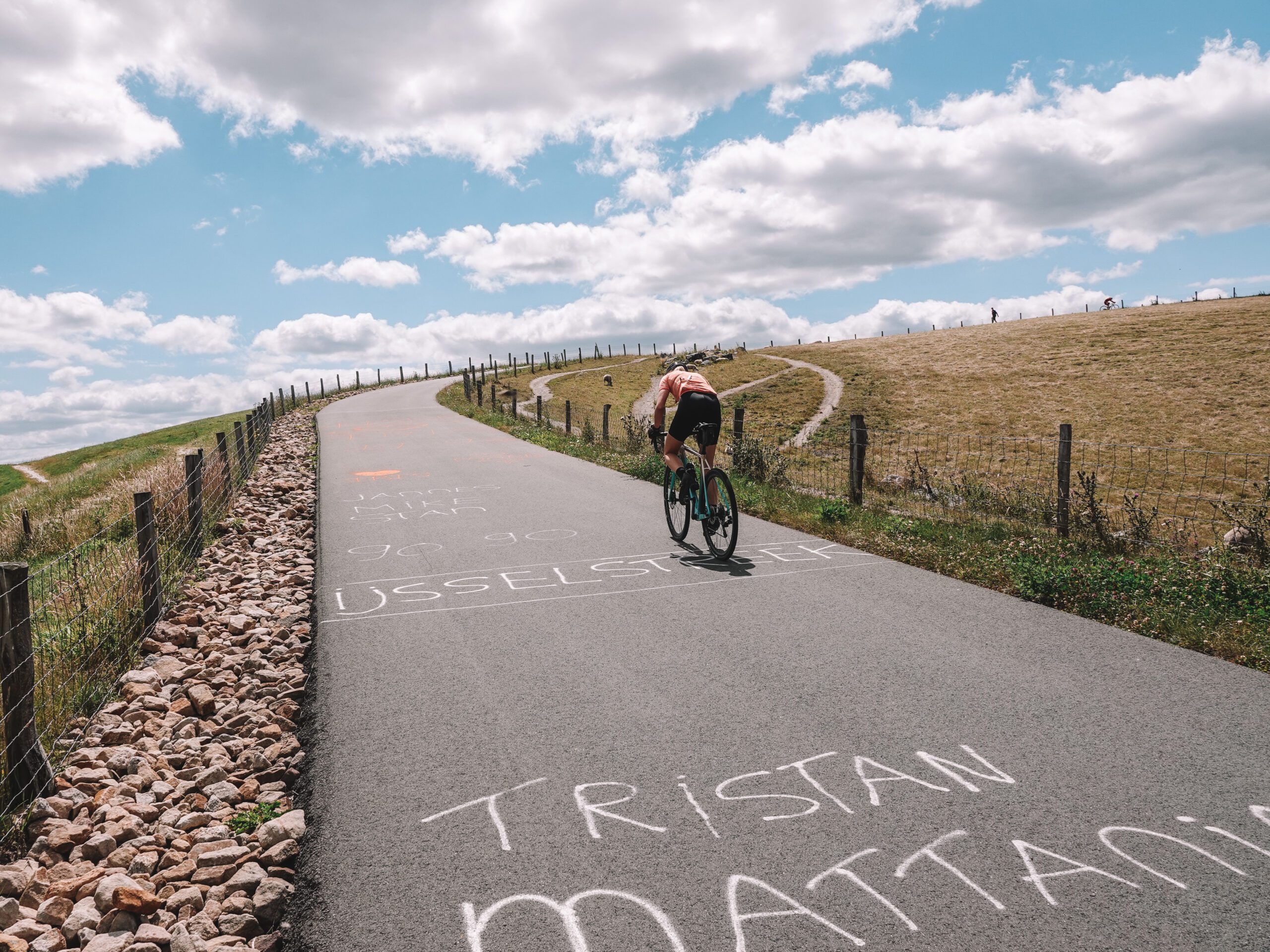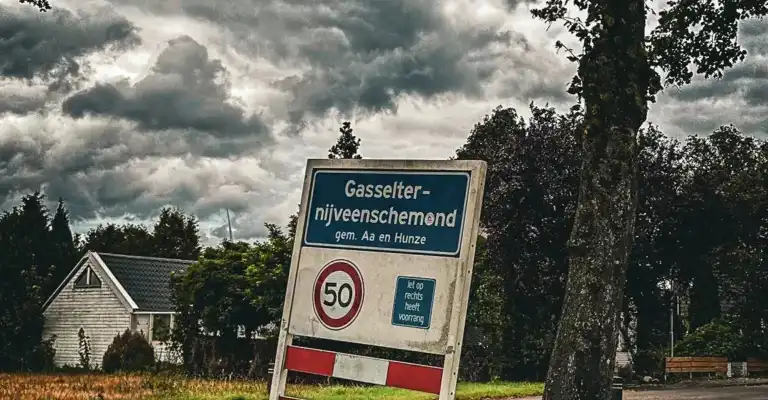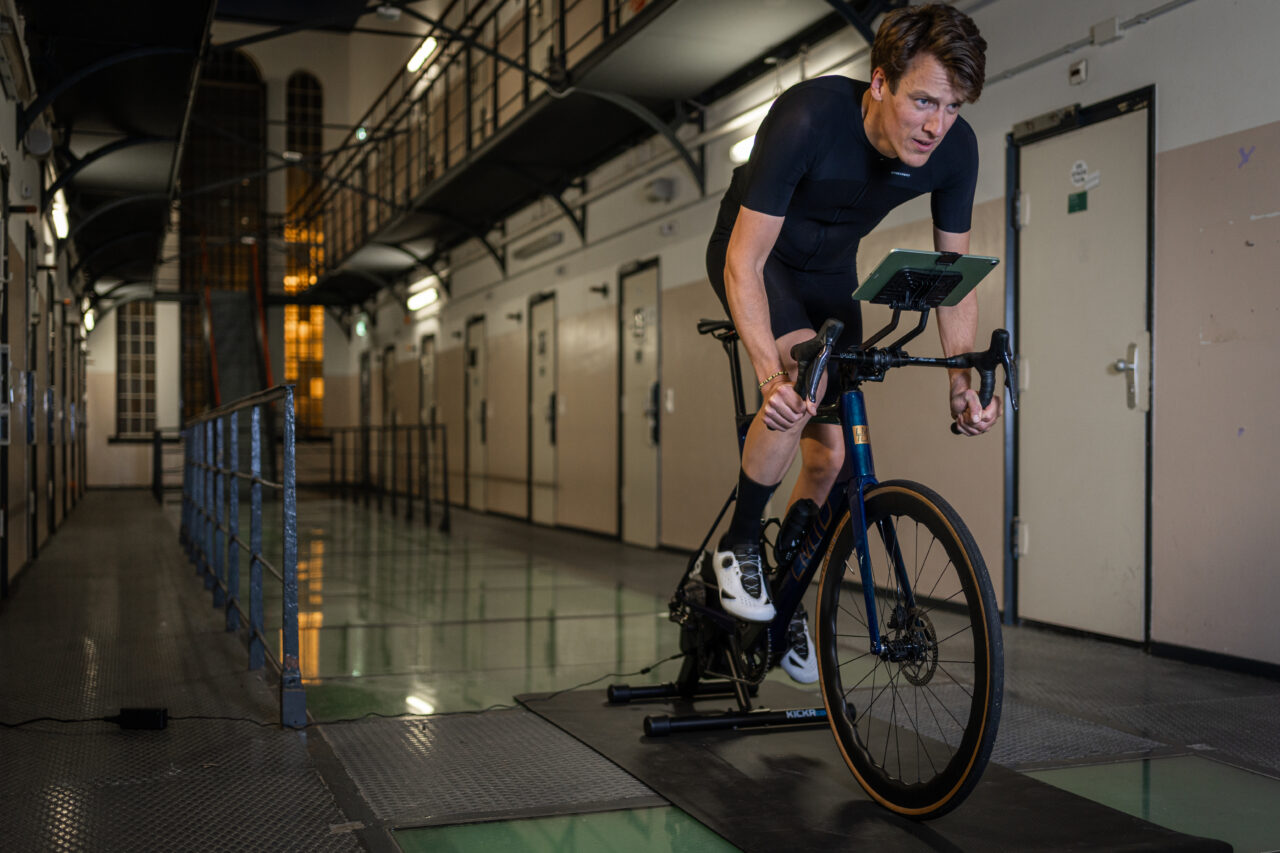One thing is for sure: Granada is more than the Alhambra and nearby Sierra Nevada. If you want to explore the city and its surroundings on a road bike, we have a big tip for you: head south towards the Costa Tropical. There you will not only find beautiful routes, but you can also enjoy the view with your feet in the water after a long ride. And with a bit of luck, you can see Morocco on the other side. In May 2025, we cycled from Granada to the Costa Tropical, stayed a night on the coast and returned. Whether it was beautiful? Yes indeed!
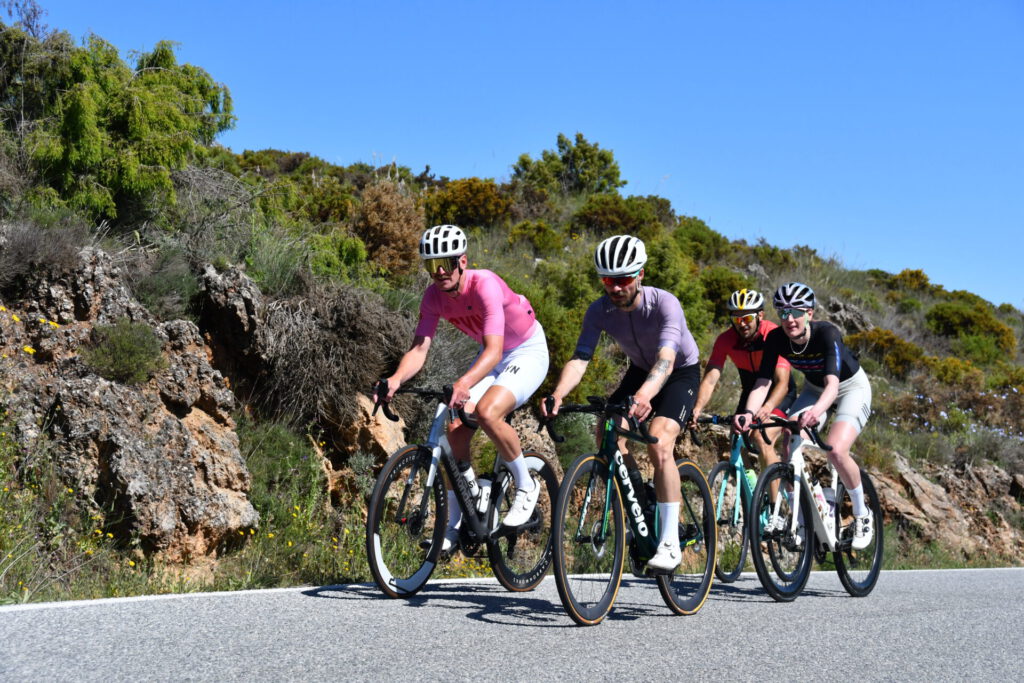
Granada is a great city
We are in Andalusia for a total of six days. We'll bivouac for a day with our friends from Visma-Lease-a-Bike in and around the Sierra Nevada, we'll spend a day graveling in the Geoparque de Granada and we visit the Alhambra, of course. But for a nice long trip, with a lot of altitude metres, we have to go to the Costa Tropical. This coastline is unknown to many. After all, all of cycling Europe heads for Calpe or Girona in Spain. If one goes wild, it might be the Basque Country or a bit of the Pyrenees, but the southern part of Andalusia is often ignored. Unjustifiably so, if you ask me.
Via the goat track to Salobreña
As we get ready to start cycling today, we just need to plot the route towards Salobreña, our final destination. This friendly town, perched on a hill on the coast, is a perfect spot to end up. To get there, though, we still have to conquer some mountains. We are at 600 metres altitude in Granada, but we'll add another 1,000 altimeters to that nicely. That means a longer descent to sea level. Along the way, we actually ride up one long climb. This one is funnily enough called 'Carretera de la cabra' or 'goat path'. Could it be more Spain/Vuelta than this?
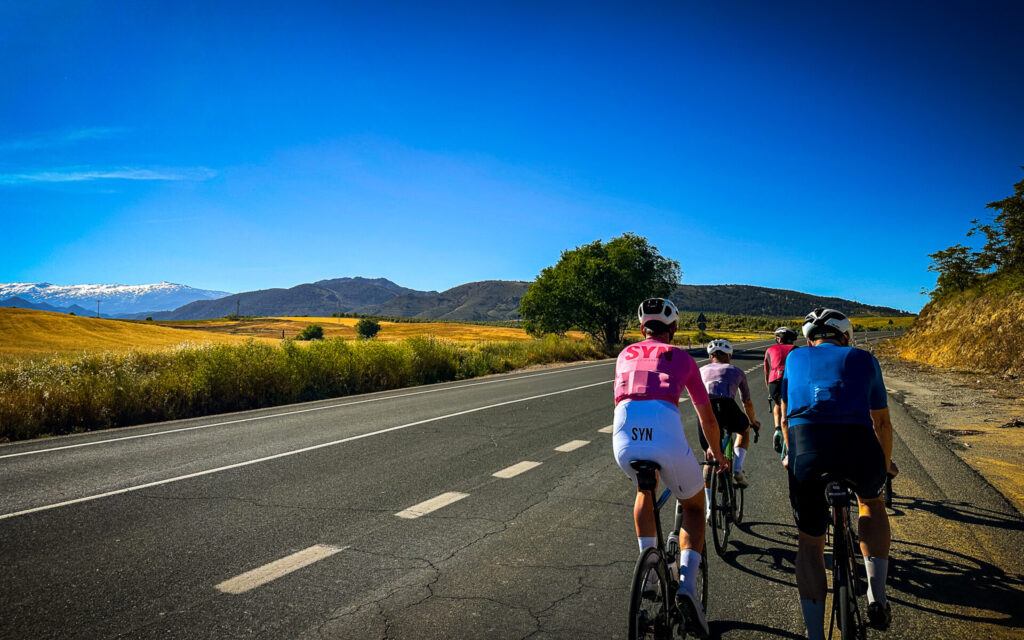
Infrastructure in order?
Getting out of town in Granada is still a survival mission for a while. Traffic is relatively heavy and, although in Spain you are obliged to keep 1.5 metres distance from cyclists, cars still tear past hard. In the middle of the city, it is sometimes difficult to find a wide cycle lane. Once we have left the city, one can be found, but it is made of such slippery asphalt that you don't want to ride on it with a splash of rain. Another disadvantage: on the cycle path, you have no priority over cars in many places. At roundabouts, for instance, or at an entrance to a petrol station. Then it's better (especially with a group) to ride two-by-two on the road.
The mountains call
It takes about 10 kilometres of typical straight Spanish roads, with the occasional roundabout before we cross a larger road and we start climbing. We actually ride the goat trail from the other side. So the official route is with start at the coast (at Almuñecar to be precise) and then up. It is not yet super warm in May, but with 20 degrees plus and climbing, you work up a sweat quickly. The climb is about 14 kilometres long in total until the first summit, but then you ride on a sort of plateau for a while, going up and down. That also lasts another 15 kilometres and only then does the long, tight, winding descent begin.
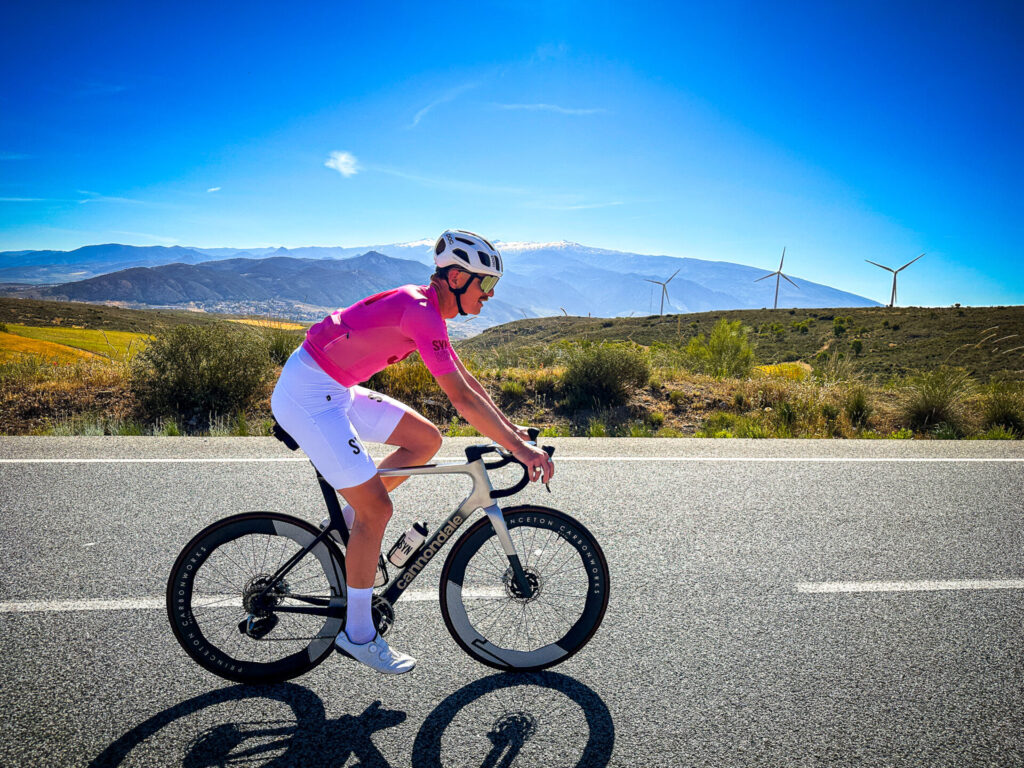
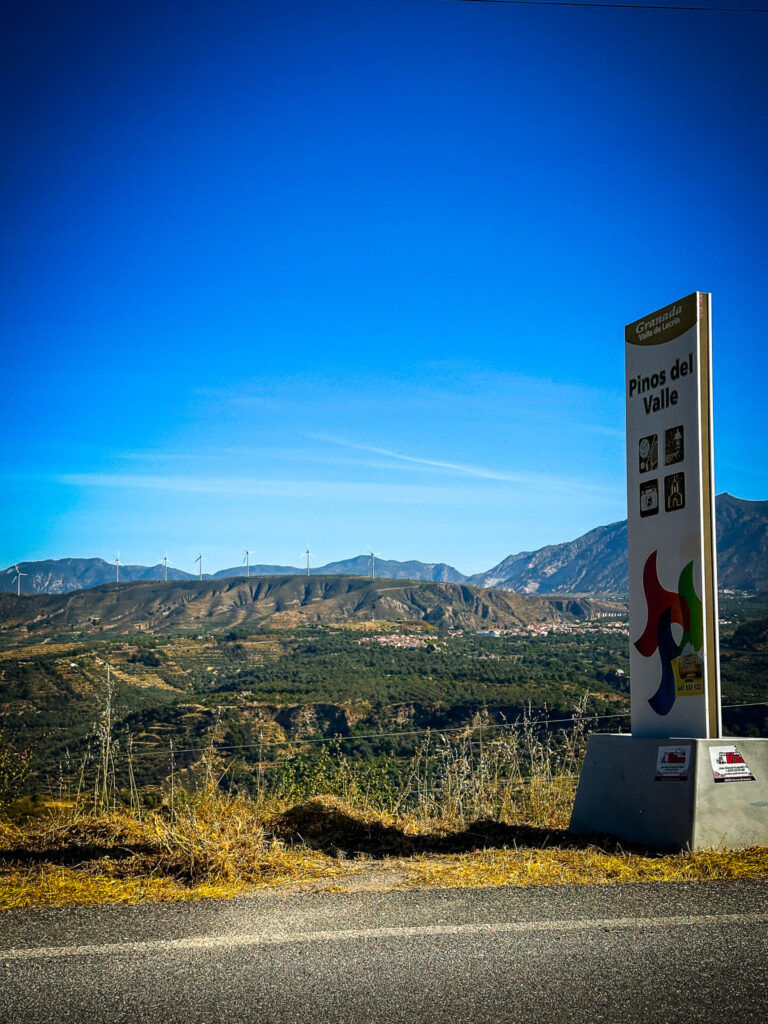
Up you see mostly beautiful scenery. It also gets quieter the higher we go. We drive a bit through the Parque eólico Loma de Capón. On the left you see the windmills and straight ahead you see the specific Spanish vegetation of this region. There are some trees, and some stones that seem to be covered with greenery. I have to say that for a goat trail, the road surface this way up is pretty good. No big holes or cracks in the road, fine tarmac and rolling nicely, in other words!
We have a follow car along on this trip (Toni from TunTunTrip) and that's a good thing, because the water supply is not so good on this route. You will come across one restaurant, where you can fill your water bottles, but make sure you have enough to drink. Better to be shy than shy.
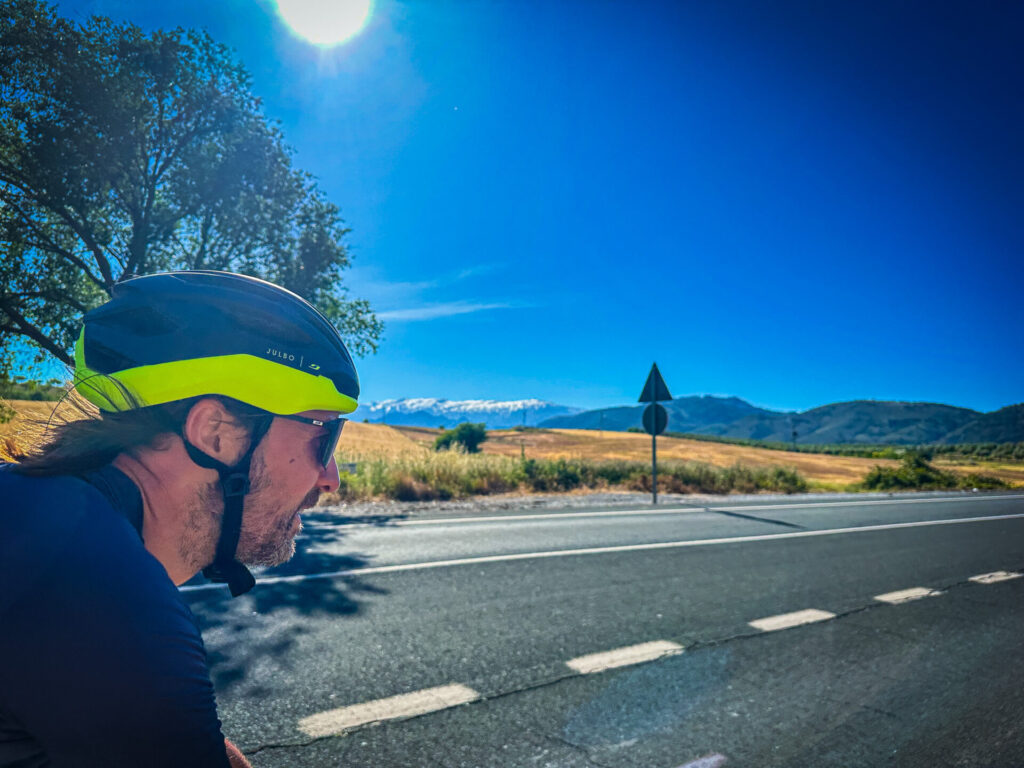
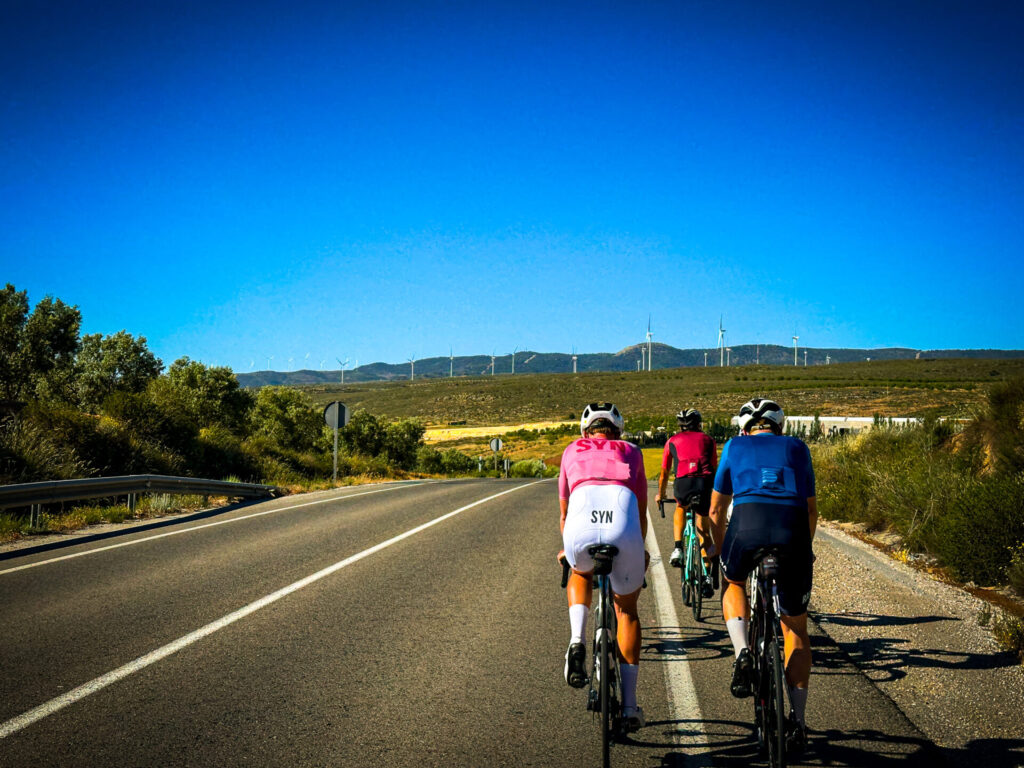
Atop the plateau
So once at the top, that plateau follows. It is beautiful and you really feel like you are in the middle of a mountainous area.You are at an altitude of about 1350 metres here and you actually see all kinds of mountain peaks. The Komoot map also shows a lot of 'cerros', i.e. mini peaks. However, you can only cycle up one of them, at least on a road bike. With the MTB there will probably be more possible, although there seems to be no MTB path here
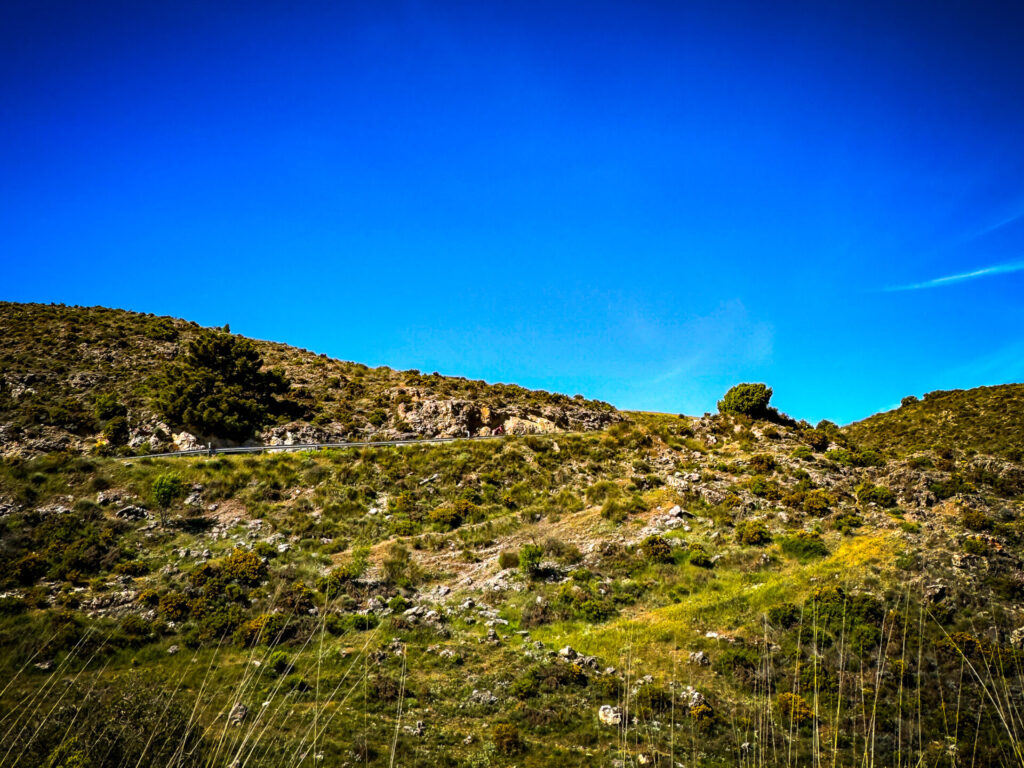
The goat trail lives up to its name after all
One of the things that make this climb and descent beautiful is its winding nature. You get some great photo opportunities. It is a road that looks more like a snake stuck to the mountain than it is a goat path. However, what does make it a goat path is the width of the road. In doing so, the first few kilometres of the descent are well worn. Combine that with occasional stones that have fallen off the wall and I am already constantly with my hands on the brake levers. I am used to some things, but I find that I still prefer to just come down. The fact that the Dutch Porsche club is also keen to race here for a while makes for extra caution. Men with assertiveness in a Porsche Convertible...
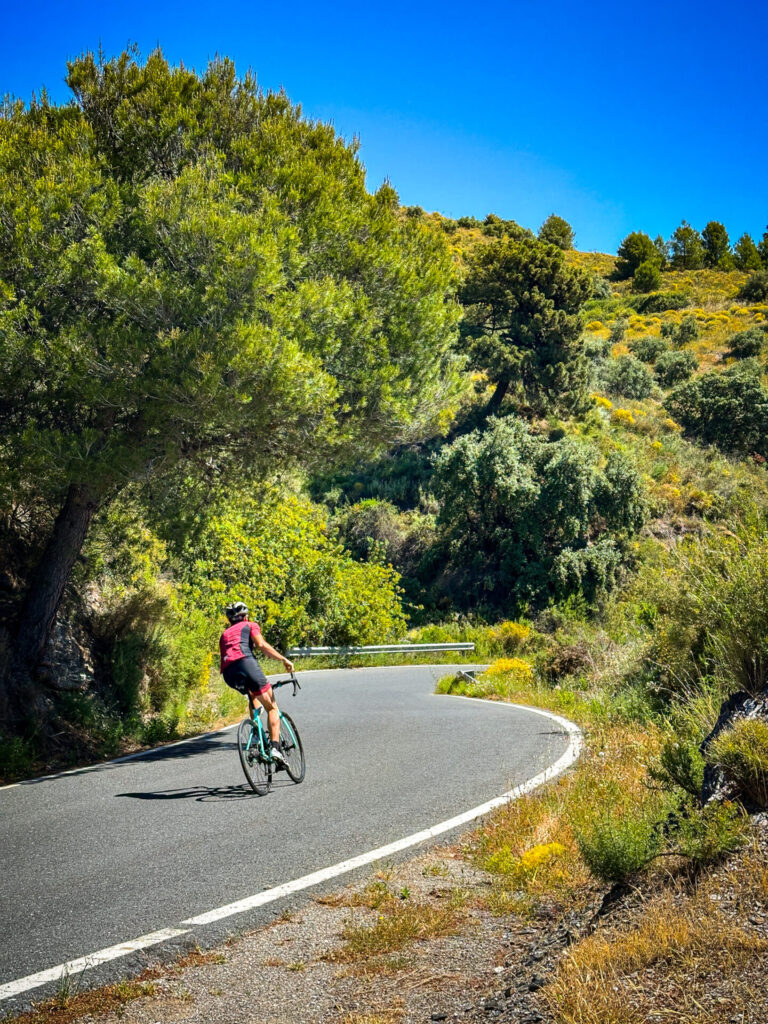
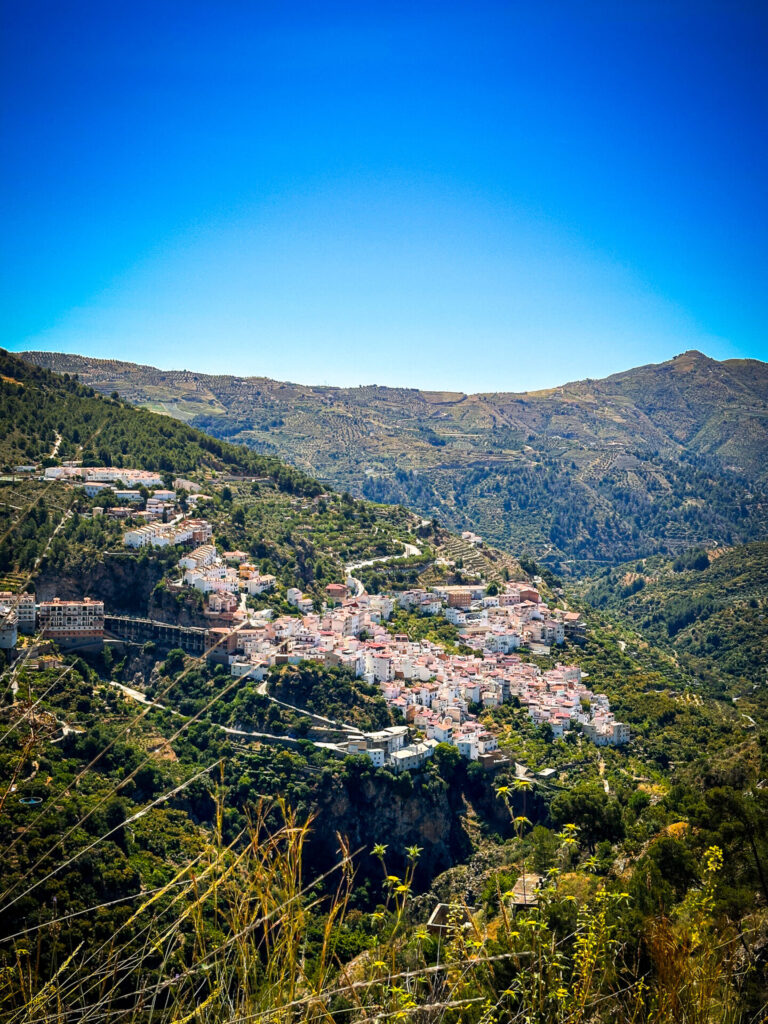
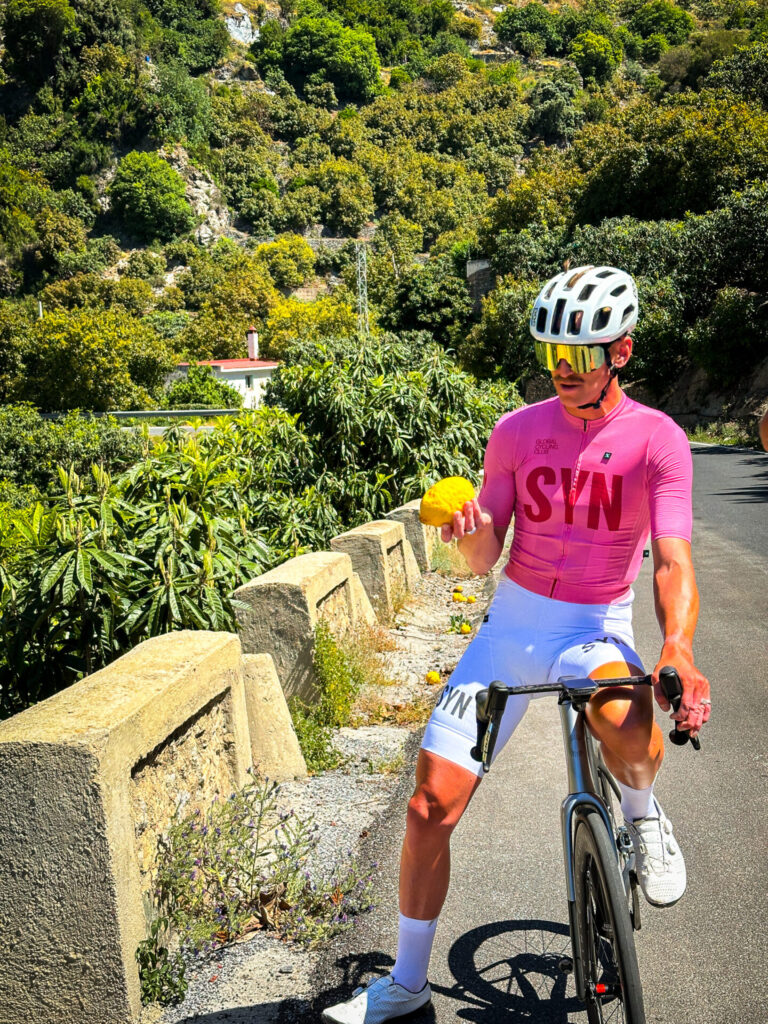
Once down, the road gets busier and busier and we also see more buildings again. At 62 kilometres on our route (78km in total), we re-enter the first village in Otivar. If you were riding a round trip (i.e. about 160 kilometres), this would be a good place to stop for a quick snack and refilling the water bottles. In the village is a pretty stone pillar asking us to come again to the 'balcony of the rio verde'. Do we.
Through traffic
The last stretch to Almuñecar is really a transit route with a lot of traffic. You'll just have to move with the flow a bit. Once at the coastline, we have nice time to shoot the classic pictures along the promenade, where the sun is still beautiful in the sky and the sea provides the perfect backdrop. We are only too happy to take advantage of it. Our drive ends at Chiringuito el Tesorillo, a top spot on a sort of bay in Almuñecar. The lunch of paella is truly delicious. Whether it's the sea you hear murmuring or just the relaxed atmosphere, it makes the food extra tasty. The last few kilometres to Salobreña are still treacherous, though. Because to get there you really have to overcome a steep climb. If you keep following the coastline, 500 metres at over 12% average await you. Gulp. If you navigate properly for a while you take the bigger road and it's all a bit friendlier.
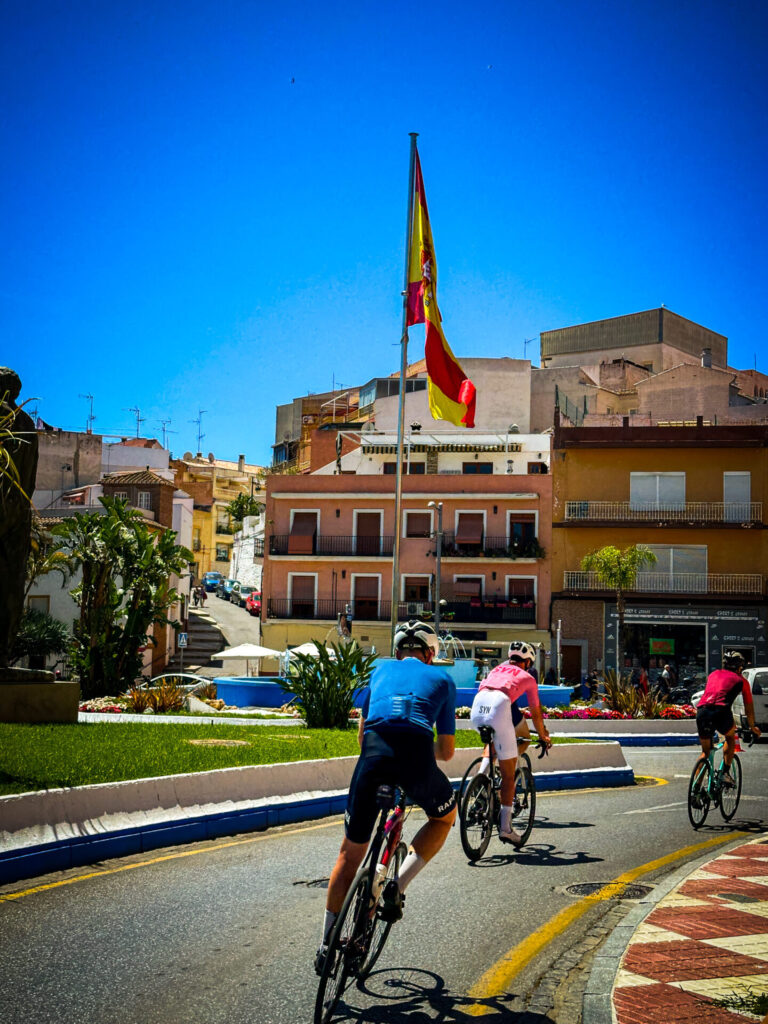
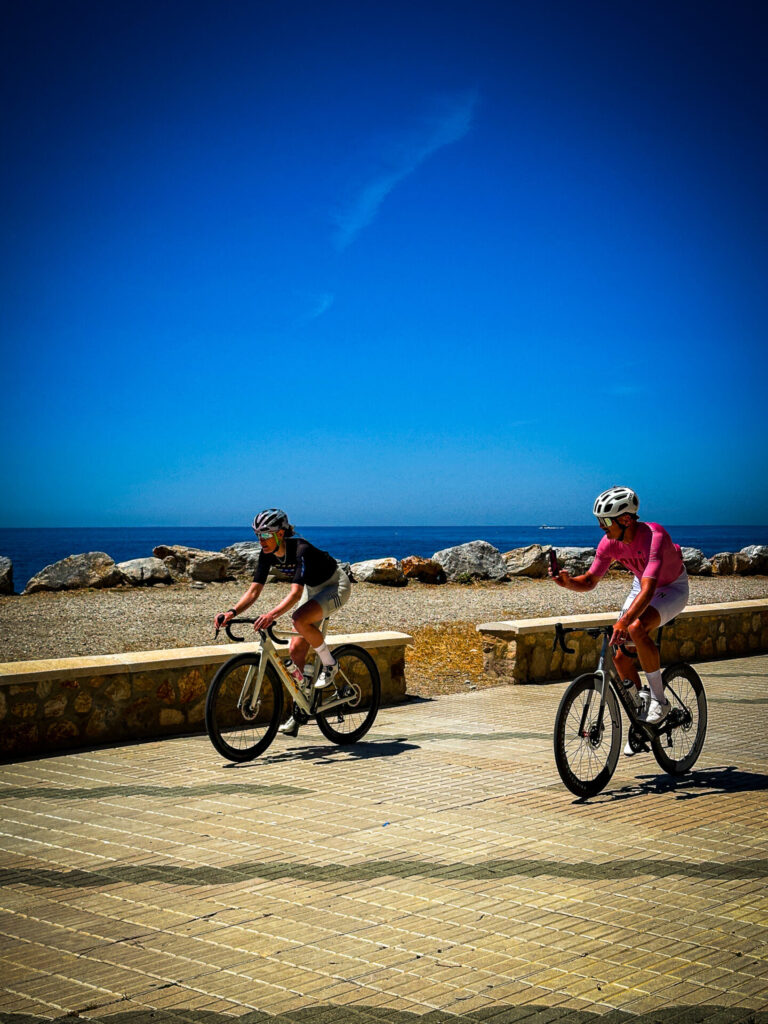
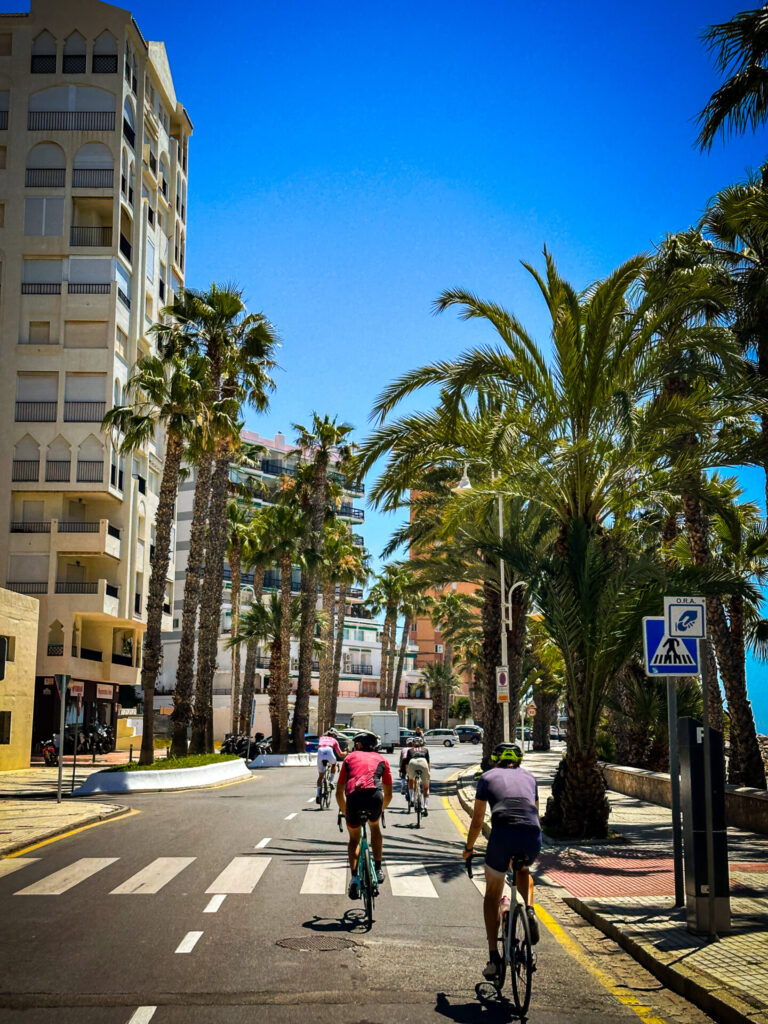
Salobreña forms the heart of the Costa Tropical
The town of Salobreña, as mentioned earlier, is located on a hill. It is a strategic location, where the Castillo de Salobreña can also be found. Or at least, its ruins. This centuries-old castle dates back to the Middle Ages and was used by various kings and dynasties both as a summer residence and also as a prison. It is located at the highest point and to get there you walk through the narrow, steep streets, past the pretty white houses of the town. Very atmospheric, but also painful for the feet and legs after a long bike ride. But the view at the top makes up for a lot. Dinner a little further on at La Traviesa tastes extra good as a result. A big tip is to eat at one of the seafood restaurants on the coast, especially Restaurant Pil Pil, which makes super tasty fish, both fried as a starter and simply grilled.
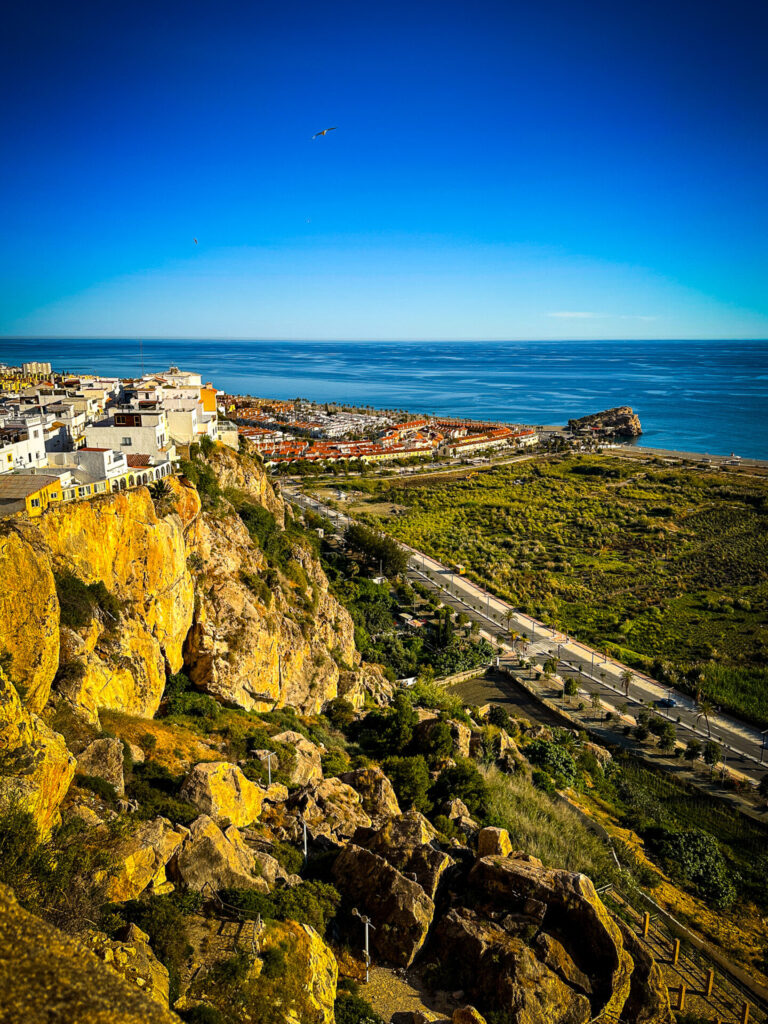
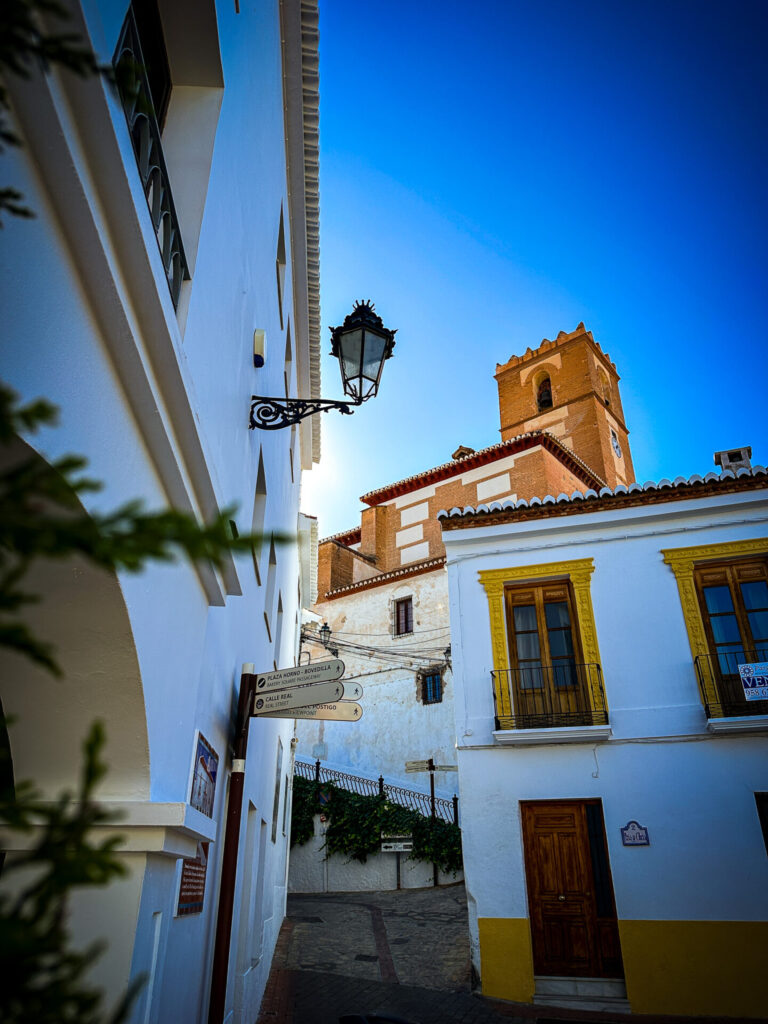
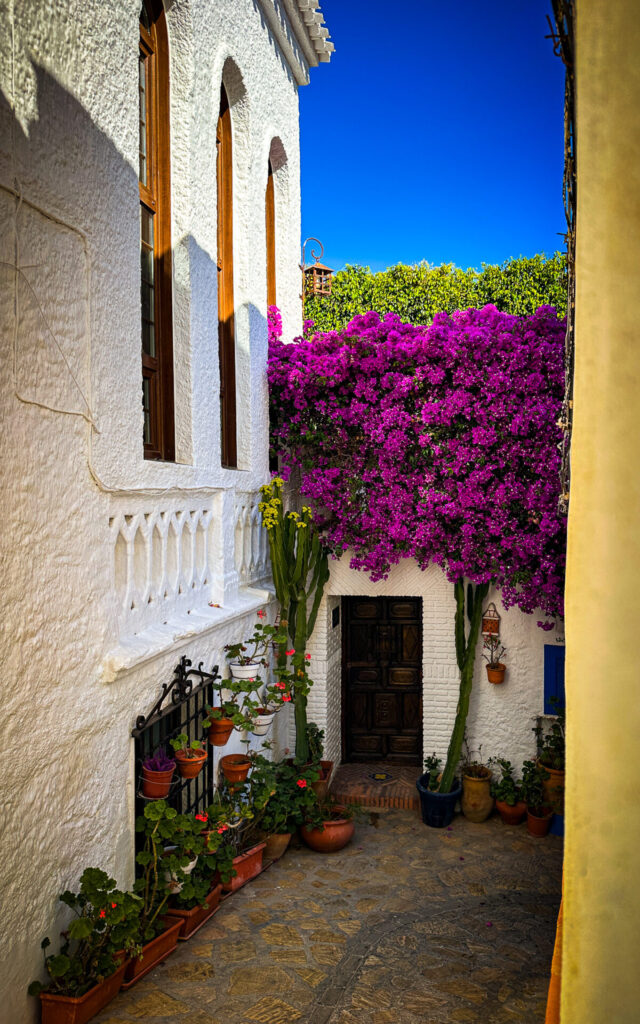
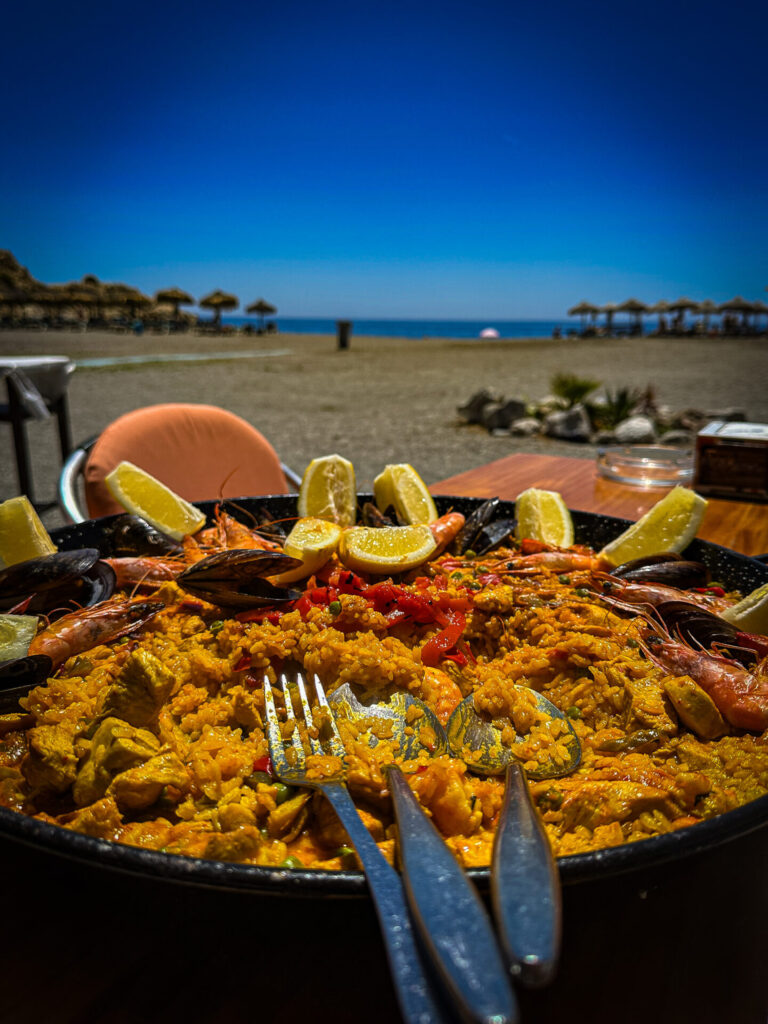
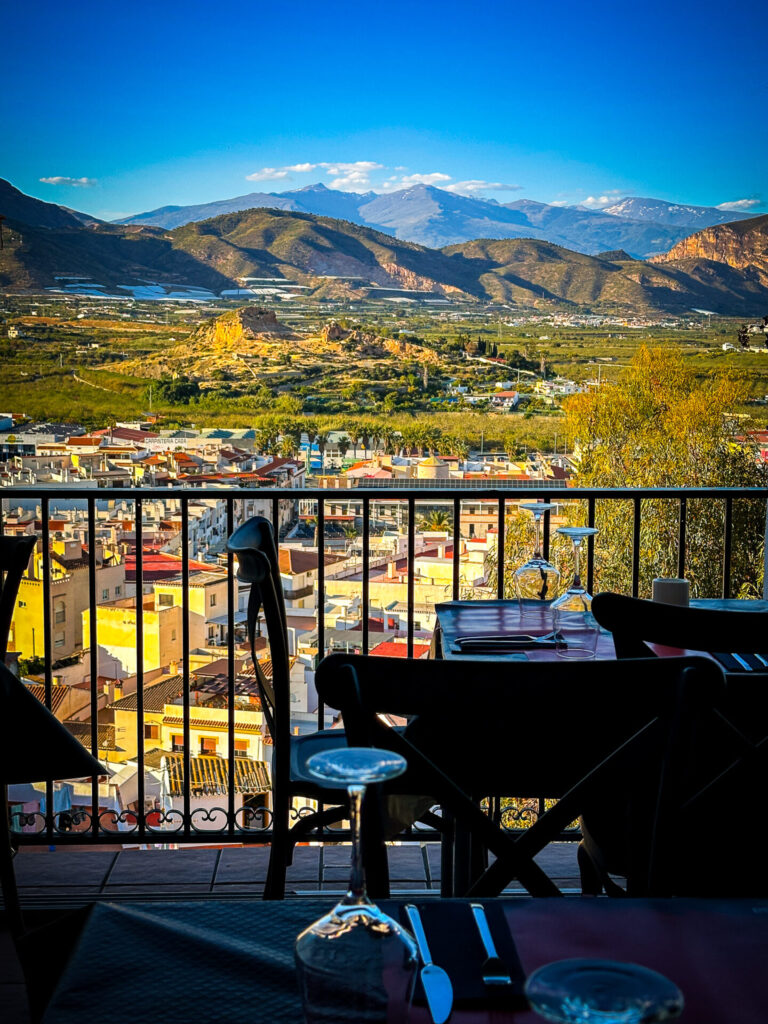
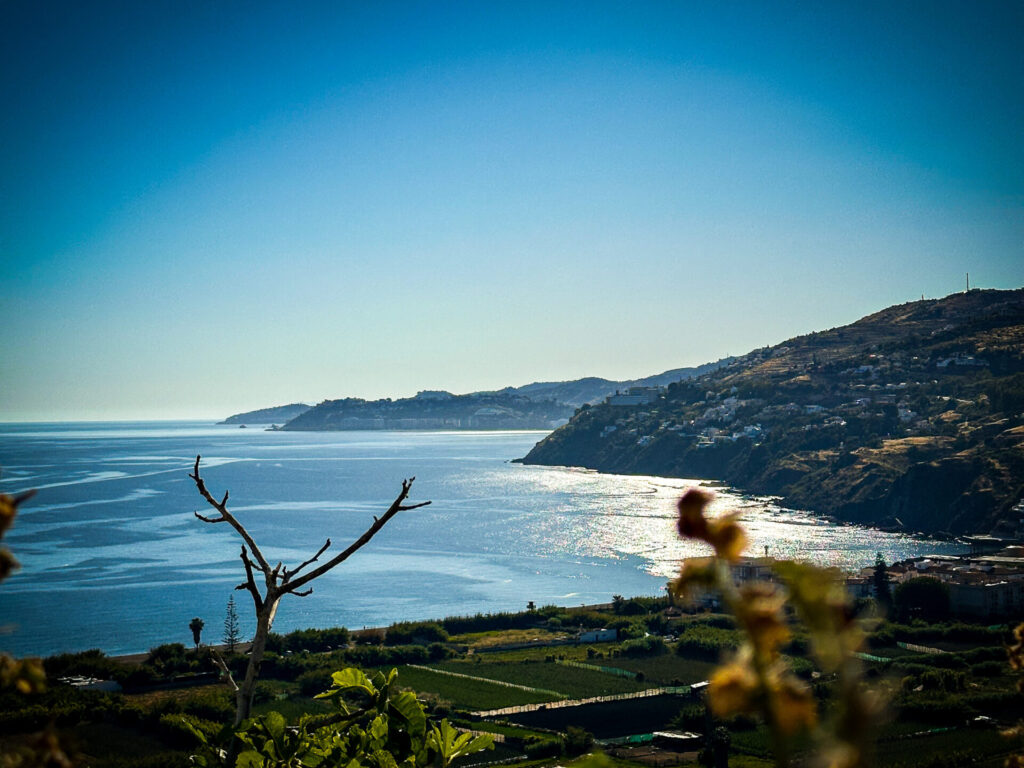
We sleep in a solid Spanish hotel, Hotel Avenida Tropical, with typical antique wooden interior, doors and a bed that the tall Dutchman can just fit into. It is clean, everything is there and the air conditioning works. Then I am soon happy. There is no bike cellar yet, nor a place to clean your bike. That's a point for improvement.
Reservoirs in the region
Our two days on the Costa Tropical brought us back to Granada. Some of our group started the return journey early in the morning and took the climb from the coast to the Beznar dam, at the Beznar reservoir. I myself will join our guide and another journalist in the bus.
There are two large reservoirs near the Costa tropical. One reservoir, from Rules, is larger and has several (beautiful) viewpoints. Unfortunately, you can't do a tour of the reservoir, but you could make a lap along the lake from Salobreña or Motril. We start on top of the Beznar dam, where we meet the others again. The ride towards it is quite a climb and when we unload the bikes on the dam, the view is already impressive. I myself love water. Sea, river, lake. I think I like mountain lakes best, but a reservoir is always impressive too.
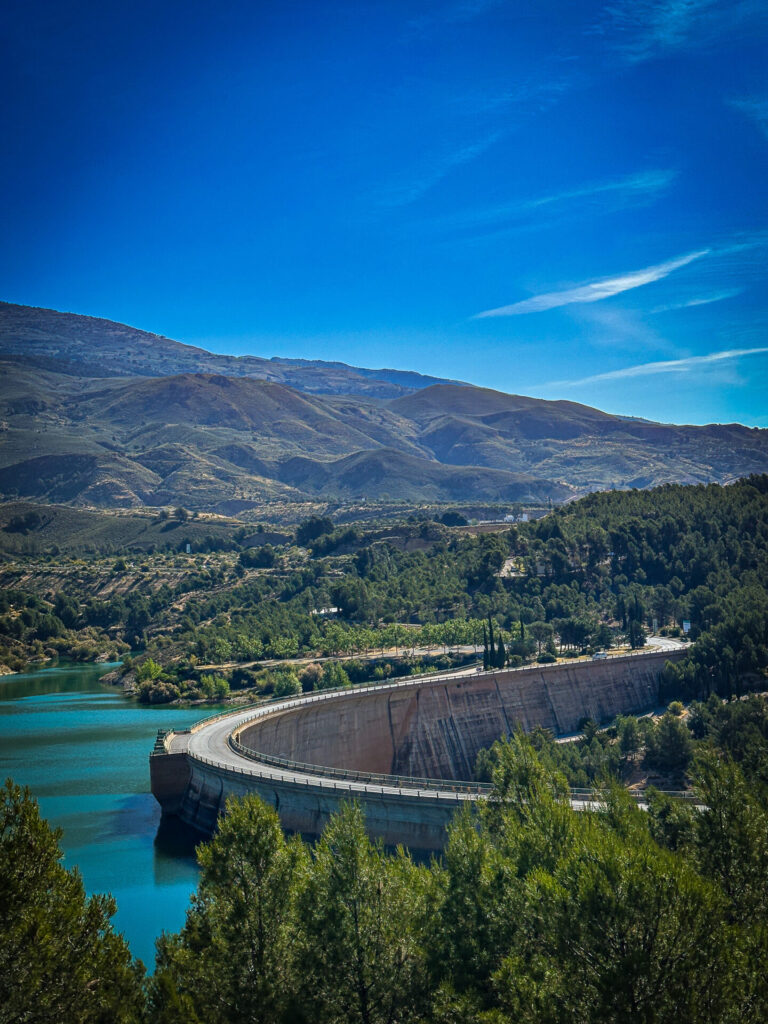
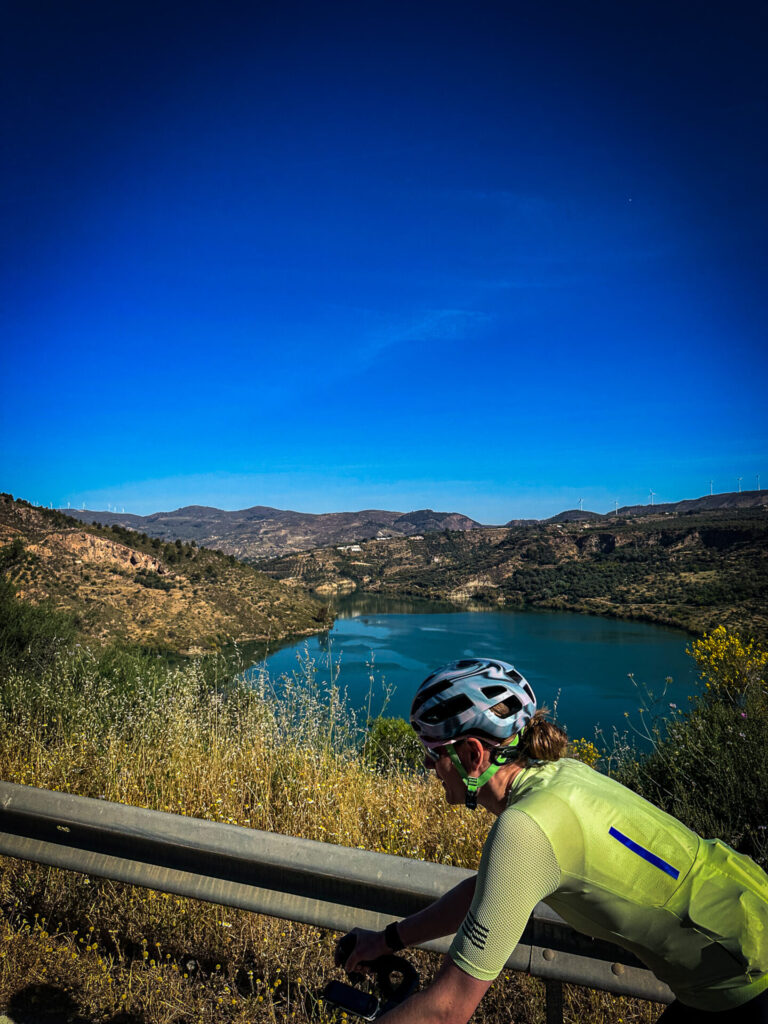
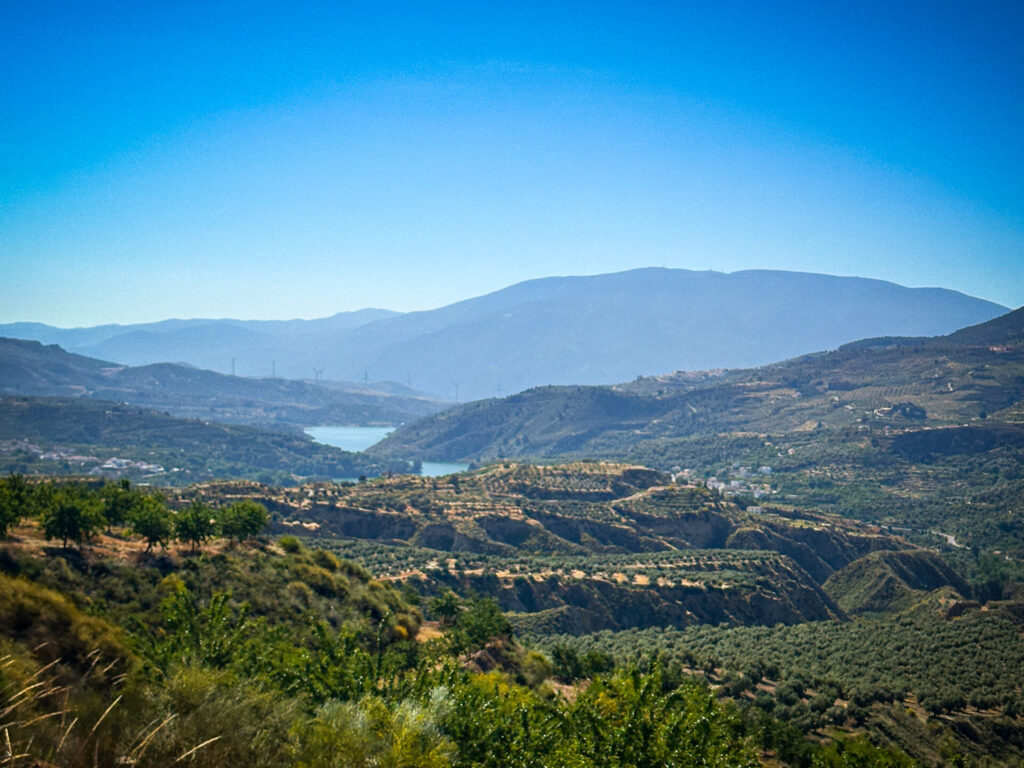
And up again
With our drive to the dam in the car, we have already made quite a few altimeters, yet there is still a whole load of altimeters waiting for us behind it. From the Dam, it's straight uphill. Once at the top, in Pinos del Valle, we have a short breather but then it's straight on. Guide Toni has put a few vicious climbs in the course. As I ride up with Marcus, a fellow Danish traveller, we both look at our GPS in mild panic. Fifteen, sixteen, seventeen. Yes those are not metres, but percentages. It's raking and behind us a coach is eager to pass. You could do better.
Once at the top, we then see the typical hilly landscape again, with green vegetation and sometimes endless roads. It is fairly quiet here with traffic. We don't actually encounter other cyclists. Sometimes a village, where you can stop for a drink or a tapa. With sounding names like Albuñelas, Conchar and Padul, we are presented with a nice row of Spanish villages. Soon the points of the Sierra Nevada loom again in the distance. That still remains an amazing sight.
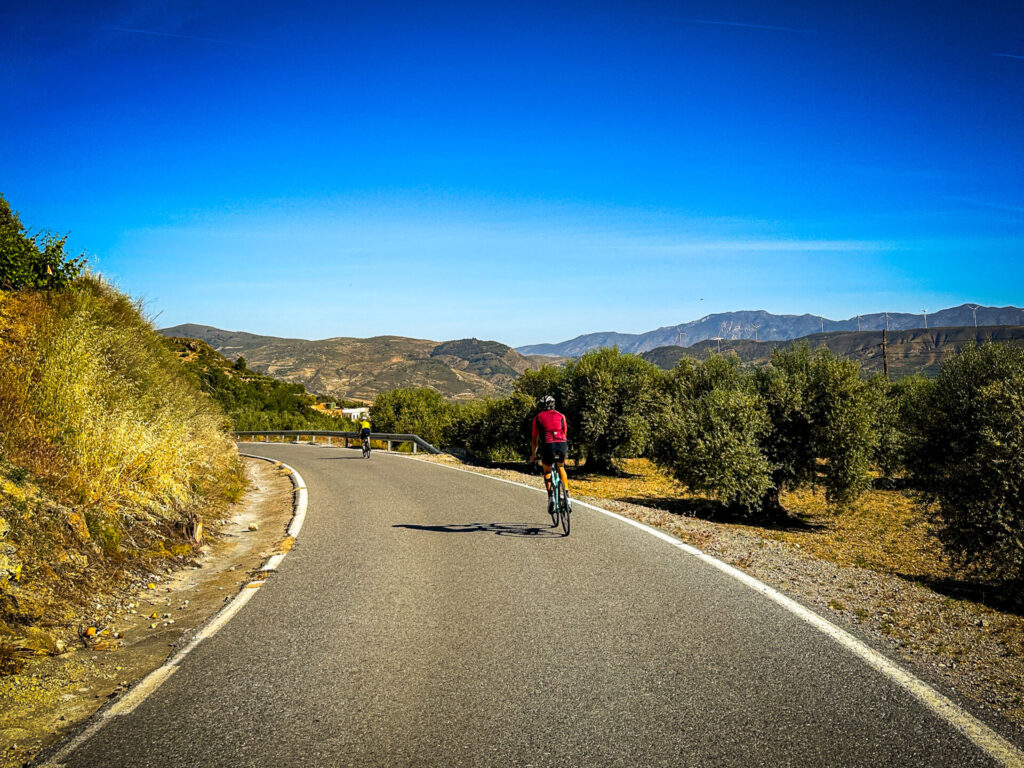
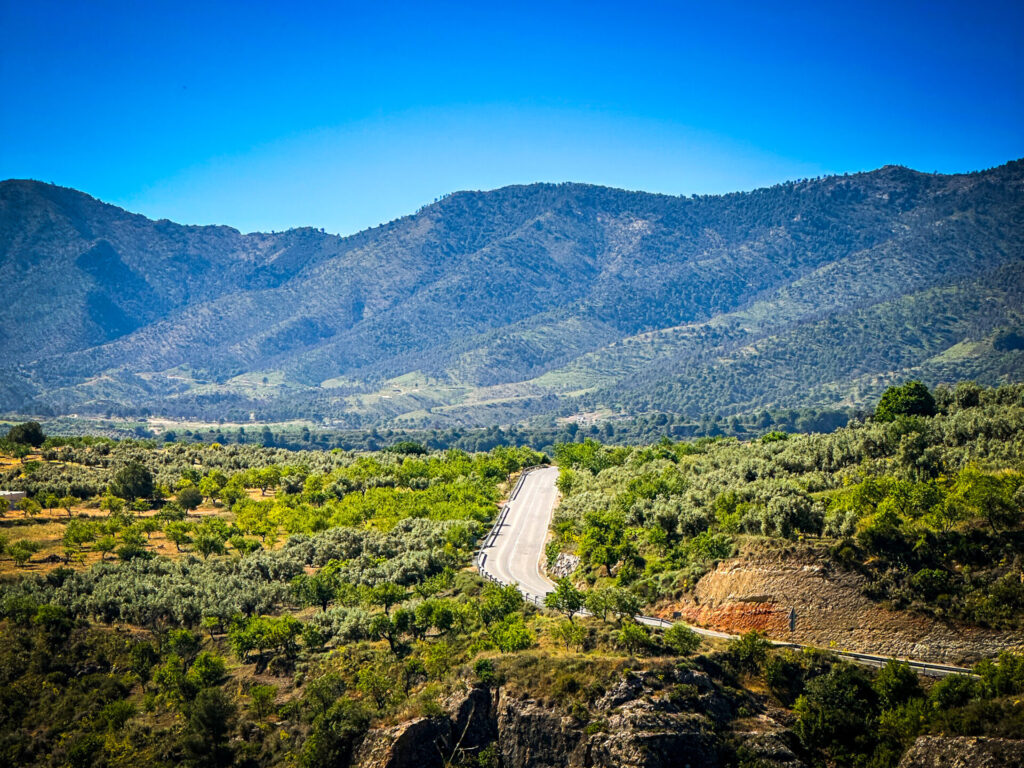
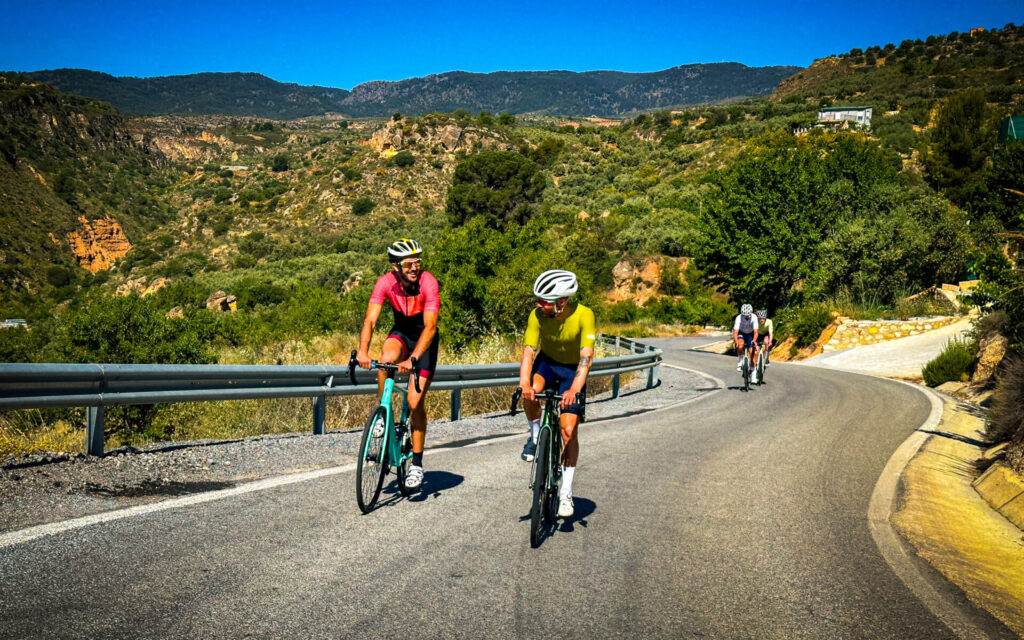
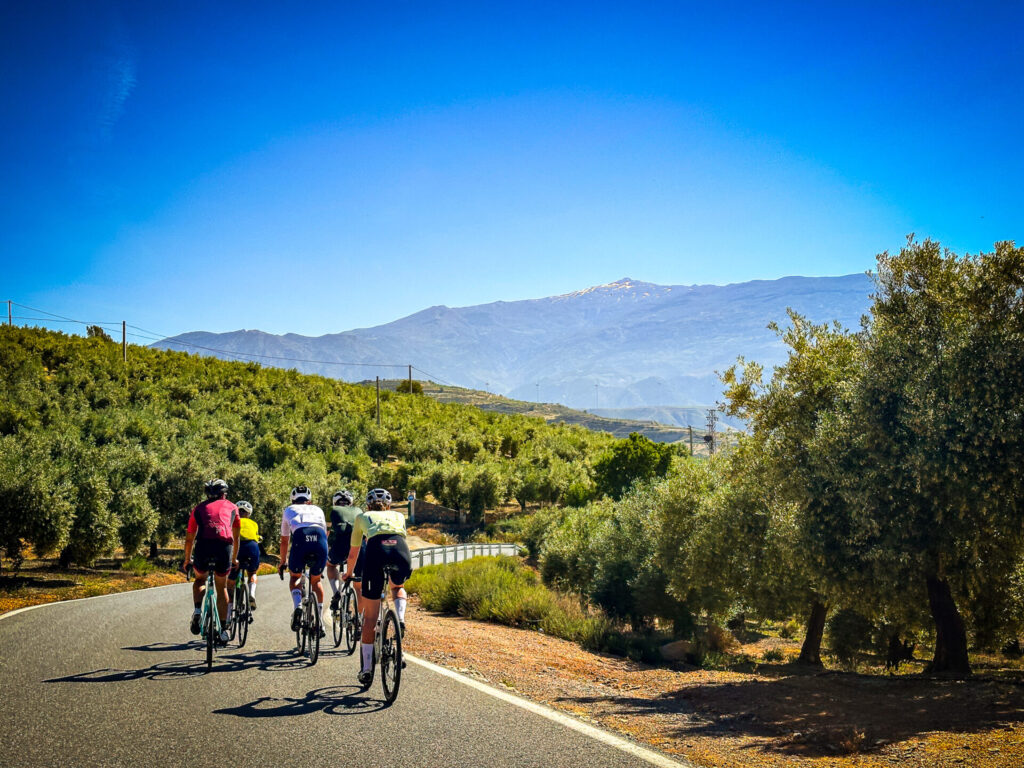
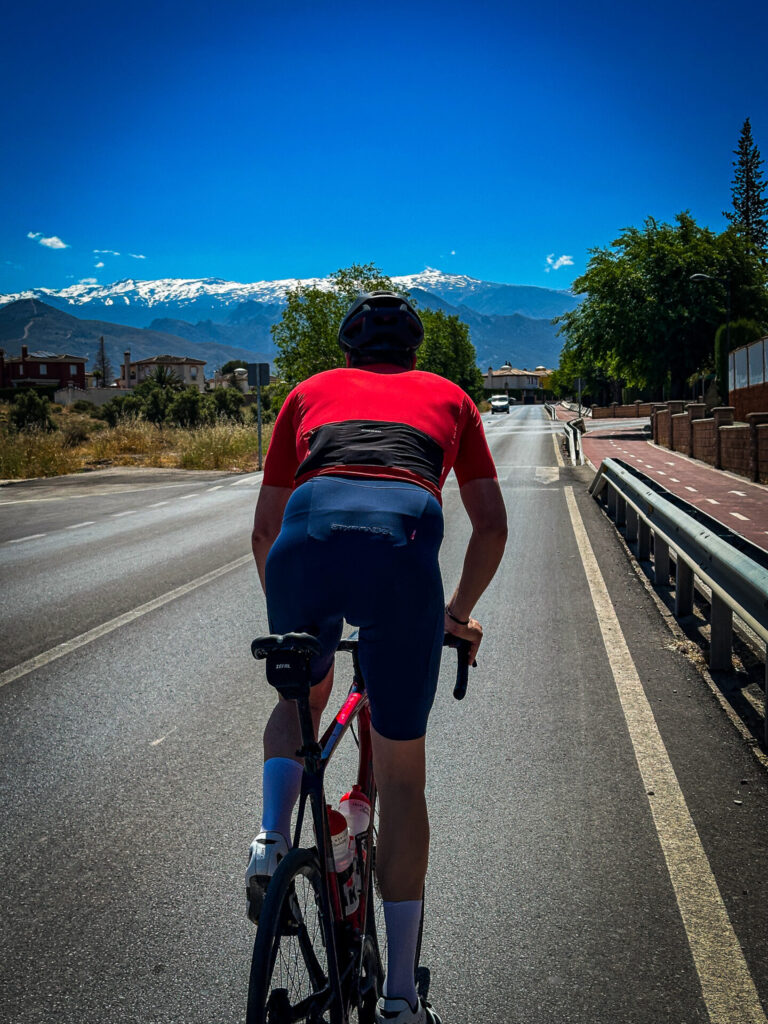
Back at the beginning
The last stretch we ride the same route we rode 'out of town'. We ride on the larger road again, avoiding the cycle paths and thereby the precarious traffic situations. The traffic is up to it, but you have to shift gears mentally in particular. Once back at our hotel, a nice shower and a good lunch await us. Life in Spain is good.
Tips & Tricks
- Bring plenty of water, especially in the months of June to August. Also then, avoid driving between 11am and 3pm. It is far too hot then and you are far too much 'out in the open'.
- On the costa tropical, you have several hotels suitable as cycling hotels. Look at, among others. Helios Hotel Costa Tropical
- In Granada, we stayed in Eurostars Hotel San Anton. A lovely hotel with good facilities and close to the city centre. You only have to park your bike behind reception. Bike hotels in Granada are still hard to find.
- Along the Costa Tropical, you will find beautiful routes. Also check out this item What we wrote earlier.
- Flying directly to Granada is possible these days with Transavia.

